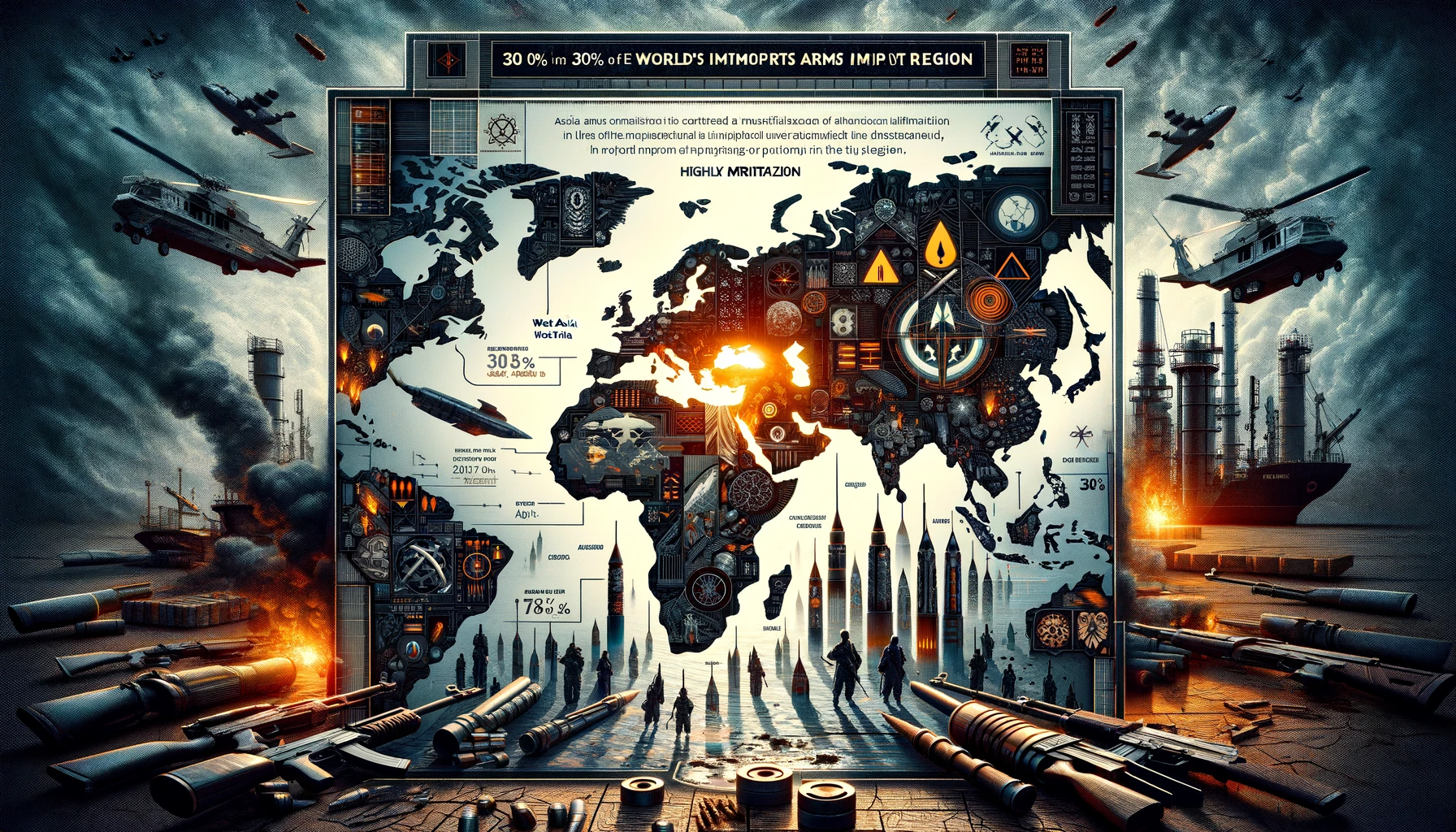Introduction:

West Asia, with its intricate geopolitical fabric, stands as a testament to one of the world’s most militarised regions. The recent report by the Stockholm International Peace Research Institute illuminates this stark reality, revealing that West Asia accounts for a significant 30% of the world’s arms imports. The area is a central hub for global energy resources, yet it is plagued by incessant conflicts that threaten its stability. This editorial delves into the complexities of the region, examining the undercurrents of the escalating tensions that not only shape the local dynamics but also have far-reaching implications on global peace and security. As we explore the ramifications of such militarization, it becomes evident that understanding these developments is crucial for anyone keen on global political landscapes.
Origin of the Article: This editorial is inspired by “Tensions grow in West Asia, a heavily militarized region,” published in The Hindu on April 25, 2024. The piece reflects on a report highlighting the region’s status as a major arms importer.
Relevancy for UPSC Students
For UPSC aspirants, understanding the dynamics of West Asia is indispensable. This region’s geopolitical and security issues are directly tied to GS Paper II (International Relations) of the Mains examination. Insights into the militarization and the ongoing conflicts can enhance one’s analytical skills and provide a deeper understanding of international diplomacy and security, crucial for both Prelims and Mains.
Here’s a revised version that maintains a formal tone while simplifying the language:
Exploring the Causes of Recent Turmoil in West Asia
The conflict began when Israel initiated military operations in Gaza. In response, Hezbollah, the Lebanese Shia group supported by Iran, retaliated by firing rockets at Israeli forces in the Shebaa Farms—a territory controlled by Israel but claimed by Lebanon.
Arab nations have expressed their displeasure with Israel’s extensive bombing campaigns, choosing diplomacy over retaliation to exert pressure on Israel.
Furthermore, militias backed by Iran have opened new fronts in the conflict against Israel. The Houthis, Shia militias from Yemen, attacked commercial ships in the Red Sea in mid-November, aligning themselves with the Palestinians. This disrupted the operations of major shipping companies in a crucial maritime route that connects the Mediterranean Sea with the Arabian Sea through the Suez Canal and the Bab el-Mandeb Strait.
Israel has also conducted multiple strikes in Syria and Lebanon, targeting leaders from Hamas, Hezbollah, and Iranian forces. In retaliation, Iran launched attacks on January 16 in Iraq’s Kurdistan, Syria, and Pakistan, targeting what they claimed were a Mossad operational center and Sunni Islamist militants.
Military spending in West Asia remains high, with countries like Saudi Arabia, Qatar, Jordan, Oman, Kuwait, and Israel allocating significant portions of their GDP to defense. The region also employs a higher proportion of its labor force in the military compared to other regions, reflecting the ongoing state of readiness for conflict.
Identifying Key Players and Their Divergent Objectives in West Asia
The conflict in West Asia involves several key players, each with distinct objectives:
Israel: Israel’s primary goal is to dismantle Hamas, secure the release of hostages, and neutralize threats to its national security. Its military operations in Gaza and targeted strikes in surrounding regions are aligned with these objectives.
Hamas: As a Palestinian Islamist political and militant group, Hamas aims to challenge Israeli policies and actions in Gaza and the West Bank. This group has been in prolonged conflict with Israel, seeking changes through militant activities.
Iran: Iran supports various anti-Israel non-state actors across West Asia, including Hamas, Islamic Jihad, Hezbollah, and the Shia militias in Iraq and Syria. Iran’s strategy is to expand its influence in the region, often countering U.S. and Israeli interests.
Hezbollah and Other Militias: These groups, frequently supported by Iran, participate in the conflict primarily in opposition to Israel and to advocate for Palestinian causes.
United States: The U.S. supports Israel and aims to maintain regional stability while protecting its interests. It has a significant military and diplomatic presence in the region, focusing on ensuring the security of Israel, the safety of American troops and assets, and the maintenance of a U.S.-led regional order.
Other Regional Actors: Countries like Pakistan have their own strategic interests in the conflict, influenced by religious, political, and regional dynamics.
- Strategic Alliances and Influence: The strategic military relationships of West Asian nations reveal that countries like Saudi Arabia and the UAE attribute over 50% of their arms imports to their alliances with the United States, illustrating the weight of American military influence in the region.
- Defense Over Other Sectors: Economic strategies in West Asia show a striking emphasis on defense, with some nations allocating up to 10% of their GDP to military expenditures, a stark contrast to global averages which often lie below 2%.
- Geopolitical Leanings: Dependency on external powers for as much as 100% of military hardware in cases like Iran with Russian supplies, unveils deep geopolitical ties and strategic dependencies that underscore the region’s complex diplomatic chessboard.
- Societal Military Engagement: With regions in West Asia leading in the percentage of the labor force engaged in military service, some areas see up to 4% of their total labor force donning military uniforms, which shapes the societal fabric and labor allocation.
- Trade-Offs in Resource Allocation: The high prioritization of military spending, especially in nations where it exceeds 10% of the GDP, inevitably leads to trade-offs, often at the expense of other critical public sectors such as education, healthcare, and infrastructure.
- Military Expenditure and Economic Policies: The extensive military budgets in West Asia, at times dwarfing other regions by maintaining consistently high percentages over three decades, showcase the significant role military considerations play in shaping the economic landscape and policy-making of these nations.
- Impact on Global Security Dynamics: The pattern and volume of military expenditure in West Asia, characterized by substantial percentages of GDP and labor force commitment, not only dictate regional security dynamics but also play a significant role in global defense and security trends.
Approaches to Resolve the West Asian Conflict
Negotiations and Two-State Solution: A widely supported approach involves negotiating a two-state solution where Israel and Palestine would exist as independent states. This includes setting clear borders, resolving the status of Jerusalem, and providing security for both nations. Historical efforts like the Oslo Accords have focused on these goals, with backing from entities such as the United States, the United Nations, and the Arab League.
Ceasefire and Humanitarian Assistance: Immediate ceasefire agreements, supported by countries like Egypt and Qatar, aim to temporarily halt conflicts and alleviate civilian suffering. International organizations play a crucial role in providing humanitarian aid to affected areas in Gaza and the West Bank.
International Mediation: The United Nations and other neutral bodies are instrumental in mediating peace talks, focusing on core issues like land disputes, resource access, and refugee rights.
People-to-People Initiatives: Grassroots initiatives encourage dialogue and cooperation between Israelis and Palestinians, including joint ventures in business, education, and culture to foster mutual understanding.
Human Rights and International Law: Efforts are made to ensure both parties adhere to international humanitarian law, with the International Criminal Court (ICC) monitoring war crimes and the United Nations addressing issues like illegal settlements.
Regional Cooperation: This includes initiatives like the Arab Peace Initiative, which seeks normalization between Israel and Arab states as part of a comprehensive peace agreement, and regional summits promoting stability.
Economic Development: Programs aim to improve living conditions and economic opportunities in both Israeli and Palestinian communities through organizations like the Palestinian Investment Promotion Agency and international donor-supported projects.
Security Measures: Measures including peacekeeping missions by the United Nations and security arrangements help reduce regional violence and enhance safety.
Educational Initiatives: Educational programs and cultural exchanges aim to promote mutual understanding and tolerance between the communities, enhancing peace prospects.
Conclusion
Understanding the intricate conflicts in West Asia is crucial for UPSC aspirants, as these disputes are rooted in both historical and contemporary geopolitical factors. This complexity requires a nuanced understanding and a balanced approach that prioritizes both strategic interests and the pursuit of peace. For future civil servants, it’s essential to grasp these international dynamics not only for examinations but also to contribute to a world where diplomacy prevails over conflict. This editorial emphasizes that knowledge, understanding, and empathy are vital in the pursuit of peace, inspiring upcoming leaders to commit deeply to global harmony.

